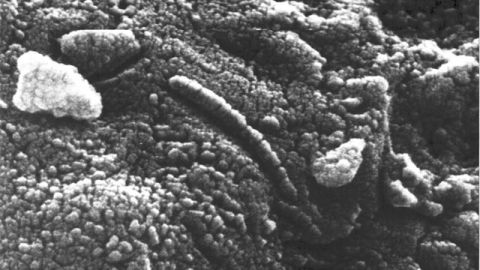Life…As We Don’t Know It

This article originally appeared in ReaClearScience’s Newton Blog. You can read the original here.
It’s amusing and intellectually stimulating to seriously ponder the existence and characteristics of alien life. But like quantum mechanics, such contemplations can easily wrack the mind, leaving one quite discombobulated. I can only imagine the self-inflicted vexations suffered by astrobiologists, whose livelihoods require daily ruminations about life on inconceivably faraway worlds.
After all, the vast randomness inherent to the evolutionary process can give rise to creatures the likes of which we cannot fathom. You’ve undoubtedly heard the maxim “Life finds a way.” Well, if life has indeed found a way on one of the other trillions of planets in our Milky Way Galaxy, it would likely not be our way.
So what would life resemble instead?
My favorite answer to that question originated from the 1976 paper “Particles, Environments, and Possible Ecologies in the Jovian Atmosphere,” penned by astrophysicists Carl Sagan and E. E. Salpeter. With learned speculation and fascinating imagination, they envisioned what life could be like on a planet like Jupiter. If such a planet were hospitable to life, the native fauna and flora wouldn’t be anything like that on Earth.
In the dense clouds, rich in hydrogen and helium with traces of ammonia, methane, and water, tiny floating organisms could suddenly spring up, jolted into existence by electrical discharges more than 1,000 times as powerful as lightning here on Earth. These creatures could be photosynthetic autotrophs, gaining energy from sunlight and making their own food. Or they might very well be heterotrophs, feasting on organic molecules like ethane and methane. In their paper, Sagan and Salpeter called these organisms “sinkers.”
Over many thousands of years, these sinkers could evolve or coalesce into new life forms: “floaters.” Resembling gigantic jellyfish, these immense “living balloons” might be the size of small cities. They could stay buoyant by pumping heavy gasses from their interiors or by keeping their hydrogen-filled insides warm. Through their amazingly thin skin, floaters might absorb and feast on the much tinier sinkers.
Salpeter and Sagan conceived of these floaters “arrayed in great, lazy herds as far as the eye can see, concentrated in the updrafts in the enormous sea of clouds.”

In the 37 years since Sagan and Salpeter envisaged sinkers, floaters, and hunters, we’ve learned much about Jupiter. We now know that these life forms do not exist, at least in our solar system. Jupiter’s atmosphere may simply be far too turbulent and hostile. Or perhaps life never received the improbable, yet necessary spark.
But the nonexistence of sinkers, floaters, and hunters has not dimmed the search for life in our stellar neighborhood. In fact, Jupiter’s moon Europa is one of the likeliest candidates to harbor life. At the bottom of the moon’s ice-covered ocean, microbes might very well persist among hydrothermal vents, using a process called chemosynthesis to convert inorganic molecules into usable nourishment.
Imagine if — one day — we found something; even just a speck! In the landmark television series Cosmos, Carl Sagan asserted that such a discovery would “deprovincialize biology.”
“It will show us what else is possible.”
(Images: 1. Structures on ALH84001 meteorite by NASA via Wikimedia Commons 2. Hunters & Floaters via Carl Sagan’s Cosmos)





